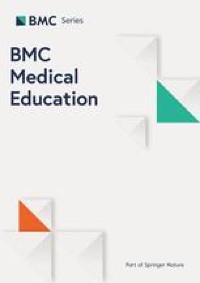-
Vos T, Allen C, Arora M, Barber RM, Bhutta ZA, Brown A, et al. Global, regional, and national incidence, prevalence, and years lived with disability for 310 diseases and injuries, 1990–2015: a systematic analysis for the Global Burden of Disease Study 2015. The lancet. 2016;388(10053):1545–602.
-
World Health Organization. Depression and other common mental disorders: global health estimates. World Health Organization; 2017.
-
Baumeister H, Hutter N, Bengel J, Härter M. Quality of life in medically ill persons with comorbid mental disorders: a systematic review and meta-analysis. Psychother Psychosom. 2011;80(5):275–86.
Article
Google Scholar
-
AlJaber MI. The prevalence and associated factors of depression among medical students of Saudi Arabia: A systematic review. J Family Med Prim Care. 2020;9(6):2608–14.
Article
Google Scholar
-
Elzubeir MA, Elzubeir KE, Magzoub ME. Stress and coping strategies among Arab medical students: towards a research agenda. Educ Health (Abingdon). 2010;23(1):355.
Article
Google Scholar
-
Hope V, Henderson M. Medical student depression, anxiety and distress outside North America: a systematic review. Med Educ. 2014;48(10):963–79.
Article
Google Scholar
-
Dyrbye LN, Thomas MR, Shanafelt TD. Systematic review of depression, anxiety, and other indicators of psychological distress among U.S. and Canadian medical students. Acad Med. 2006;81(4):354–73.
Article
Google Scholar
-
Dyrbye LN, Thomas MR, Harper W, Massie FS Jr, Power DV, Eacker A, Szydlo DW, Novotny PJ, Sloan JA, Shanafelt TD. The learning environment and medical student burnout: a multicentre study. Med Educ. 2009;43(3):274–82.
Article
Google Scholar
-
Sawa RJ, Phelan A, Myrick F, Barlow C, Hurlock D, Rogers G. The anatomy and physiology of conflict in medical education: a doorway to diagnosing the health of medical education systems. Med Teach. 2006;28(8):e204-213.
Article
Google Scholar
-
Alakhtar A, Al-Homaidan H. Depression among medical students at qassim university rate, severity, and contributing factors; using BDI II. Int J Dev Res. 2014;4:1768–72.
Google Scholar
-
Jarwan BK. Depression among medical students of Faculty of Medicine, Umm Al-Qura University in Makkah, Saudi Arabia. Int J Med Sci Public Health. 2015;4(2):184–91.
Article
Google Scholar
-
Bashir TF, Hassan S, Maqsood A, Khan ZA, Issrani R, Ahmed N, Bashir EF. The Psychological Impact Analysis of Novel COVID-19 Pandemic in Health Sciences Students: A Global Survey. Eur J Dent. 2020;14(S 01):S91–6.
Article
Google Scholar
-
Saraswathi I, Saikarthik J, Senthil Kumar K, Madhan Srinivasan K, Ardhanaari M, Gunapriya R. Impact of COVID-19 outbreak on the mental health status of undergraduate medical students in a COVID-19 treating medical college: a prospective longitudinal study. PeerJ. 2020;8:e10164.
Article
Google Scholar
-
Ghazawy ER, Ewis AA, Mahfouz EM, Khalil DM, Arafa A, Mohammed Z, Mohammed EF, Hassan EE, Abdel Hamid S, Ewis SA, Mohammed AE. Psychological impacts of COVID-19 pandemic on the university students in Egypt. Health Promot Int. 2020;36(4):1116–25.
Article
Google Scholar
-
Alkhamees AA, Alrashed SA, Alzunaydi AA, Almohimeed AS, Aljohani MS. The psychological impact of COVID-19 pandemic on the general population of Saudi Arabia. Compr Psychiatry. 2020;102:152192.
Article
Google Scholar
-
Alamri HS, Algarni A, Shehata SF, Al Bshabshe A, Alshehri NN, ALAsiri AM, Hussain AH, Alalmay AY, Alshehri EA, Alqarni Y, Saleh NF. Prevalence of Depression, Anxiety, and Stress among the General Population in Saudi Arabia during Covid-19 Pandemic. Int J Environ Res Public Health. 2020;17(24):9183.
Article
Google Scholar
-
Qanash S, Al-Husayni F, Alemam S, Alqublan L, Alwafi E, Mufti HN, Qanash H, Shabrawishi M, Ghabashi A. Psychological Effects on Health Science Students After Implementation of COVID-19 Quarantine and Distance Learning in Saudi Arabia. Cureus. 2020;12(11):e11767.
Google Scholar
-
Kroenke K, Spitzer RL, Williams JB. The PHQ-9: validity of a brief depression severity measure. J Gen Intern Med. 2001;16(9):606–13.
Article
Google Scholar
-
Spitzer RL, Kroenke K, Williams JB, Lowe B. A brief measure for assessing generalized anxiety disorder: the GAD-7. Arch Intern Med. 2006;166(10):1092–7.
Article
Google Scholar
-
American Psychiatric Association. Diagnostic and statistical manual of mental disorders. 4th ed. 1994.
Google Scholar
-
Alsalameh NS, Alkhalifah AK, Alkhaldi NK, Alkulaib AA. Depression among Medical Students in Saudi Arabia. Egypt J Hosp Med. 2017;68(1):974–81.
Article
Google Scholar
-
Nooli A, Asiri A, Asiri A, Alqarni M, Alhilali F, Alayafi M. Prevalence of depression among medical interns in King Khalid University. Int J Med Res Prof. 2017;3:131–3.
Google Scholar
-
Alshehri AA, Alaskar FA, Albahili FK. Stress, Depression and Anxiety among Medical Students of Imam Mohammed Ibn Saud Islamic University, KSA. Egypt J Hosp Med. 2018;70(5):869–71.
Article
Google Scholar
-
Al-Khani AM, Sarhandi MI, Zaghloul MS, Ewid M, Saquib N. A cross-sectional survey on sleep quality, mental health, and academic performance among medical students in Saudi Arabia. BMC Res Notes. 2019;12(1):665.
Article
Google Scholar
-
Aboalshamat K, Hou XY, Strodl E. Psychological well-being status among medical and dental students in Makkah, Saudi Arabia: a cross-sectional study. Med Teach. 2015;37(Suppl 1):S75-81.
Article
Google Scholar
-
Lateef Junaid MA, Auf A, Shaikh K, Khan N, Abdelrahim SA. Correlation between Academic Performance and Anxiety in Medical Students of Majmaah University – KSA. J Pak Med Assoc. 2020;70(5):865–8.
Google Scholar
-
Lasheras I, Gracia-Garcia P, Lipnicki DM, Bueno-Notivol J, Lopez-Anton R, de la Camara C, Lobo A, Santabarbara J. Prevalence of Anxiety in Medical Students during the COVID-19 Pandemic: A Rapid Systematic Review with Meta-Analysis. Int J Environ Res Public Health. 2020;17(18):6603.
Article
Google Scholar
-
Farrer LM, Gulliver A, Bennett K, Fassnacht DB, Griffiths KM. Demographic and psychosocial predictors of major depression and generalised anxiety disorder in Australian university students. BMC Psychiatry. 2016;16:241.
Article
Google Scholar
-
Abdulghani HM. Stress and depression among medical students: A cross sectional study at a medical college in Saudi Arabia. Pak J Med Sci. 2008;24(1):12.
Google Scholar
-
Bojdani E, Rajagopalan A, Chen A, Gearin P, Olcott W, Shankar V, Cloutier A, Solomon H, Naqvi NZ, Batty N, Festin FE. COVID-19 Pandemic: Impact on psychiatric care in the United States. Psychiatry Res. 2020;289:113069–113069.
Article
Google Scholar
-
Saddik B, Hussein A, Sharif-Askari FS, Kheder W, Temsah MH, Koutaich RA, Haddad ES, Al-Roub NM, Marhoon FA, Hamid Q, Halwani R. Increased Levels of Anxiety Among Medical and Non-Medical University Students During the COVID-19 Pandemic in the United Arab Emirates. Risk Manag Healthc Policy. 2020;13:2395–406.
Article
Google Scholar
-
Salman M, Asif N, Mustafa ZU, Khan TM, Shehzadi N, Tahir H, et al. Psychological impairment and coping strategies during the COVID-19 pandemic among students in Pakistan: a cross-sectional analysis. Disaster Medicine and Public Health Preparedness. 2022;16(3):920–6.
-
Alfawaz HA, Wani K, Aljumah AA, Aldisi D, Ansari MGA, Yakout SM, Sabico S, Al-Daghri NM. Psychological well-being during COVID-19 lockdown: Insights from a Saudi State University’s Academic Community. J King Saud Univ Sci. 2021;33(1):101262.
Article
Google Scholar

























